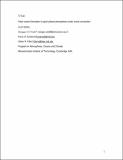Polar vortex formation in giant planet atmospheres under moist convection
Author(s)
Emanuel, Kerry Andrew; Flierl, Glenn Richard; O'Neill, Morgan E
DownloadSPV_NatGeo_MITlibcopy.pdf (629.5Kb)
OPEN_ACCESS_POLICY
Open Access Policy
Creative Commons Attribution-Noncommercial-Share Alike
Alternative title
Polar vortex formation in giant-planet atmospheres due to moist convection
Terms of use
Metadata
Show full item recordAbstract
A strong cyclonic vortex has been observed on each of Saturn’s poles, coincident with a local maximum in observed tropospheric temperature. Neptune also exhibits a relatively warm, although much more transient, region on its south pole. Whether similar features exist on Jupiter will be resolved by the 2016 Juno mission. Energetic, small-scale storm-like features that originate from the water-cloud level or lower have been observed on each of the giant planets and attributed to moist convection, suggesting that these storms play a significant role in global heat transfer from the hot interior to space. Nevertheless, the creation and maintenance of Saturn’s polar vortices, and their presence or absence on the other giant planets, are not understood. Here we use simulations with a shallow-water model to show that storm generation, driven by moist convection, can create a strong polar cyclone throughout the depth of a planet’s troposphere. We find that the type of shallow polar flow that occurs on a giant planet can be described by the size ratio of small eddies to the planetary radius and the energy density of its atmosphere due to latent heating from moist convection. We suggest that the observed difference in these parameters between Saturn and Jupiter may preclude a Jovian polar cyclone.
Date issued
2015-06Department
Massachusetts Institute of Technology. Department of Earth, Atmospheric, and Planetary Sciences; Massachusetts Institute of Technology. Program in Atmospheres, Oceans, and Climate; Woods Hole Oceanographic InstitutionJournal
Nature Geoscience
Publisher
Nature Publishing Group
Citation
O’Neill, Morgan E, Kerry A. Emanuel, and Glenn R. Flierl. “Polar Vortex Formation in Giant-Planet Atmospheres Due to Moist Convection.” Nature Geosci 8, no. 7 (June 15, 2015): 523–526.
Version: Author's final manuscript
ISSN
1752-0894
1752-0908